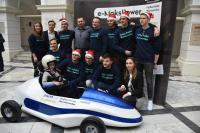WUT students built a vehicle for Maks, a disabled boy
White and blue, 2.4 m long, weighing 110 kilograms, with its useful speed of 30 km/h: meet e-MaksPower, an electrical vehicle. The students of the Warsaw University of Technology have just finished the project. They built a car for Maks – a ten-year-old suffering from muscular dystrophy and a big fan of motoring.
The vehicle’s official premiere was held in the WUT Main Building on 6 December 2019. At its culmination, Maks got into the car and demonstrated its capabilities by driving it a few times around the Grand Hall.
See the photos from the vehicle’s premiere
“We are happy that we could harness our engineering skills to help someone,” says Łukasz Krawczuk vel Walczuk, the project manager.
Goal: to make a dream come true
The idea emerged during the fair attended by the students belonging to the ADek Research Group. “Maks’s father approached us and told us about his son’s fondness for electromobility and go-karts,” describes Łukasz Krawczuk vel Walczuk. “And since ADek deals exactly with such topics, we decided to fulfil Maks’s dream and build a car tailored to his needs.”
The works were commenced in February 2018. Students from four research groups of the Warsaw University of Technology were involved in the undertaking: Students’ Research Group for Vehicle Aerodynamics, Robotics Research Group (both groups operate at the Faculty of Power and Aeronautical Engineering), ADek Research Group (operating at the Faculty of Electrical Engineering) and Inter-Faculty SmartCity Research Group (operating at the Faculty of Civil Engineering). They are the ones who handled the engineering issues. Rafał Tomczak, an Industrial Design student at the Academy of Fine Arts in Warsaw, provided graphic assistance.
Following the trends
After consulting Maks and his parents, young constructors designed a vehicle fully steerable with the use of a joystick, which would allow Maks to control the drive train, the steering system and the braking system. They planned that the drive train would be fully electrical – in line with the current automotive trends. The car would have an aerodynamic paneling adapted to this type of structures, designed and constructed by the students.
“The vehicle’s colors are not random; Maks chose white and blue when he saw the first visualizations prepared by Rafał Tomczak,” underlines Łukasz Krawczuk vel Walczuk.
Without help we’re nothing
It is one thing to devise and design. But to build is another, and more difficult, challenge. Such an ambitious undertaking required substantial financial outlays. The e-MaksPower project was supported by numerous companies and institutions: ABB, Budimex, AVL Software and Functions, AC SA, TME, Wamtechnik, Cubic Inch, LED Solar System, PSPA, PGE Foundation, Maridex Meble, Profar Lakiernia, 3D Reaktor, efilament3d and of course the Warsaw University of Technology. Also 143 donors opened their hearts and wallets: they took part in the crowdfunding action on PolakPotrafi.pl. The media also made their contribution by publishing information about the project and the collection organized for this purpose.
The students could count on the support from Maks’s parents at all times. They were in regular contact with them and kept them up-to-date with the work progress. “The project took longer than we assumed but we didn’t lose motivation because we knew that Maks waited and believed in us,” admits Łukasz Krawczuk vel Walczuk.
New goals
Now the boy can enjoy the machine, while its authors can feel the satisfaction with a job well done. “We applied the knowledge and skills we had acquired, we learnt patience, humility, time management and responsibility,” lists Łukasz Krawczuk vel Walczuk.
However, the joy and pride of the completed project do not distract the e-MaksPower authors from further goals.
“We’ve had an initial talk with some people interested in developing this project,” reveals Łukasz Krawczuk vel Walczuk. “We hope that it will be continued (under a different codename this time) and that we will keep helping make children’s dreams come true.”
About 30 people participated in the project at various stages of work related to the car. The core team members were: Łukasz Krawczuk vel Walczuk (project manager), Hubert Graczyk (responsible for the control system and onboard computer), Piotr Saffarini (designed the steering system and the structure of numerous components of the vehicle), Michał Stasiuk (architect of the control system and electronic system), Marcin Staszewski (responsible for selecting and implementing the S battery system), Michał Wielgosz (simulated aerodynamics and supervised the construction of the vehicle’s paneling), Robert Juchniewicz (design and construction of the electrical wiring), Łukasz Grab (programming of microcontrollers), Piotr Lange (mechanical properties of the ground protection plate), Joanna Kacprowska (acquisition of sponsors), Academy of Fine Arts student Rafał Tomczak (design and whole branding of the project).
Key technical data of e-MaksPower:
- Vehicle weight: 110 kg
- Max. design speed: 80 km/h
- Useful speed: 30 km/h
- Range: 20 km
- Power: 3 kW
- Battery capacity: 1 kWh
- Dimensions: 2.4 [m] x 1.3 [m] x 0.9 [m]
- Fiberglass paneling
- Cost: PLN 80k








